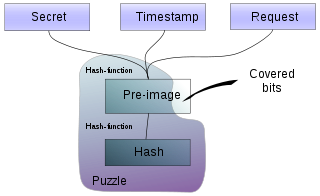
Client Puzzle Protocol
Encyclopedia

Algorithm
In mathematics and computer science, an algorithm is an effective method expressed as a finite list of well-defined instructions for calculating a function. Algorithms are used for calculation, data processing, and automated reasoning...
for use in Internet
Internet
The Internet is a global system of interconnected computer networks that use the standard Internet protocol suite to serve billions of users worldwide...
communication, whose goal is to make abuse of server resources infeasible. It is an implementation of a proof-of-work system
Proof-of-work system
A proof-of-work system is an economic measure to deter denial of service attacks and other service abuses such as spam on a network by requiring some work from the service requester, usually meaning processing time by a computer...
(POW).
The idea of the CPP is to require all clients
Client (computing)
A client is an application or system that accesses a service made available by a server. The server is often on another computer system, in which case the client accesses the service by way of a network....
connecting to a server
Server (computing)
In the context of client-server architecture, a server is a computer program running to serve the requests of other programs, the "clients". Thus, the "server" performs some computational task on behalf of "clients"...
to correctly solve a mathematical puzzle before establishing a connection, if the server is under attack. After solving the puzzle, the client would return the solution to the server, which the server would quickly verify, or reject and drop the connection. The puzzle is made simple and easily solvable but requires at least a minimal amount of computation on the client side. Legitimate users would experience just a negligible computational cost, but abuse would be deterred: those clients that try to simultaneously establish a large numbers of connections would be unable to do so because of the computational cost (time delay). This method holds promise in fighting some types of spam
Spam (electronic)
Spam is the use of electronic messaging systems to send unsolicited bulk messages indiscriminately...
as well as other attacks like Denial of Service.
See also
- Computer securityComputer securityComputer security is a branch of computer technology known as information security as applied to computers and networks. The objective of computer security includes protection of information and property from theft, corruption, or natural disaster, while allowing the information and property to...
- Intrusion-prevention systemIntrusion-prevention systemIntrusion Prevention Systems , also known as Intrusion Detection and Prevention Systems , are network security appliances that monitor network and/or system activities for malicious activity. The main functions of intrusion prevention systems are to identify malicious activity, log information...
- Proof-of-work systemProof-of-work systemA proof-of-work system is an economic measure to deter denial of service attacks and other service abuses such as spam on a network by requiring some work from the service requester, usually meaning processing time by a computer...
- Guided tour puzzle protocolGuided tour puzzle protocolGuided tour puzzle protocol is a cryptographic protocol for mitigating application layer denial of service attacks. It aims to overcome the shortcoming of computation-based puzzle protocols, in which clients are required to compute hard CPU or memory-bound puzzles that favor clients with abundant...

